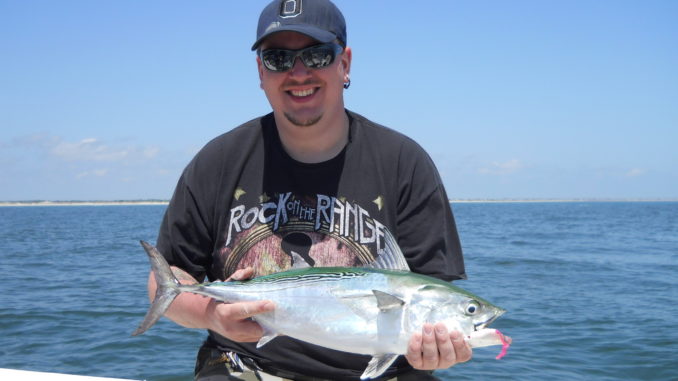
Grand Strand welcomes special guest
During spring, the saltwater fishing arena changes on almost on a weekly basis as water temperatures rise. And for a brief intermission during April, a strong push of Atlantic bonito arrive along the coast of the Grand Strand well within reach of anglers with small boats.
Atlantic bonito will move to within six to 15 miles of the beach for a period from late March to as late as May in cooler years. They are much smaller than their cousins, yellowfin and blackfin tunas, but these family speedsters slash and dash on light tackle, yielding exciting battles.
During spring, false albacore and bonito will occasionally run together and are often confused by anglers as the same species. Bonito are readily identified by their clearly undulating lateral line, with seven to 12 slightly sloping, dark stripes than run forward and downward along the dorsal section of their body. False albacore, aka little tunny, have four to five distinct dark spots scattered between the pectoral and ventral fins and will have distinctive wavy markings found dorsally above the lateral line towards the rear of the body. Albacore are inedible, bonito delicious.
As bait moves closer to shore, nearshore pelagics follow. Bonito prepare to kickoff their May to July spawning season by feeding aggressively nearshore on schooled baitfish, building fat reserves.
Tom Cushman of Calmwater Fishing Charters out of Little River, S.C., expects bonito to arrive when the water temperatures in nearshore waters reach a specified range.
“I start seeing them when the water temperature reaches 59 to 60 degrees,” said Cushman (843-997-5850). “I usually start to see them at 50 to 60 feet first, and they will get closer as the run strengthens.”
Bonito are voracious feeders. They are known to skip or leap out of the water when in pursuit of prey. Schools of bonito will also congregate and corral baitfish to the surface.
“They are usually feeding on schools of 2- to 3-inch silversides,” he said. “When they are feeding, you can spot them busting the top or can look for birds diving down on them.”
Small, flashy spoons that mimic fleeing silversides are Cushman’s favored lures. He will use typically cast weighted spoons into surfacing schools and use a rapid retrieve.
“I like ½- to 3/8-ounce diamond jigs that you can (cast) far and work real fast. The bonito have excellent vision, and you must retrieve as fast as possible to get them to strike,” he said.
Cushman will also use a long section of 20-pound fluorocarbon leader as well to conceal the main running line from these keen lookers. While casting is his preferred method, he will often resort on his charters to trolling the same types of spoons 75 to 80 yards behind the boat on 16-foot leaders.
When casting, Cushman will run to school, cut the engine, and drift close enough to cast lures into the feeding fish.


Be the first to comment